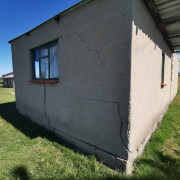|
Getting your Trinity Audio player ready...
|
By Mashudu Masutha
First published on Business Day
The extractive sector, if carefully managed, presents enormous opportunities for advancing sustainable development, particularly in low-income countries. However, resource-cursed countries such as SA may have a significantly different view.
An extractive sector rooted in accountability and transparency is key to determining a mutually inclusive form of sustainability. Unfortunately, for the SA mining sector this has not been the case, from the early days of the country’s gold rush in the 1800s to now. Vast mineral wealth, coupled with excess quantity and quality of natural resources, has earned SA’s extractive sector great admiration across the globe.
But there comes a point where forward-looking plans are seriously required, particularly because research indicates that the SA mining industry has about 15 to 20 years of significant large-scale mining left, and that the global standard is 10 to 20 years to discover, develop and bring into production new large-scale mines.
The time has come for an urgent response, and the mining licensing regime is a good place to start. For years now the mineral approvals process has required significant reform. Corruption Watch’s research report on the vulnerabilities of the licensing process identified 14 corruption risks in the application process alone.
The legislation governing the process is often sidestepped to favour those who are able to pay a bribe. Officials at the department of mineral resources & energy, who are supposed to follow legislative processes to the letter, have been involved in the very same corruption and maladministration. The SA Mineral Resources Administration System (Samrad), an online platform for all applications, has allowed corruption vulnerabilities to persist and become systemic challenges — ironically, it was initially introduced to curb corruption.
In practice, Samrad does not always function as it is meant to, and by design can be used to facilitate corrupt practices. The most glaring fault is that despite the introduction of Samrad manual submission of applications is still possible. This explains why the industry has been plagued by the double-granting of mining and prospecting rights (where a new applicant is granted rights over the same property portion as an existing prospecting or mining right) and is the original cause of many disputes.
So, for a decade, departmental officials have been unable to rely on Samrad cadastral data and have had to double-check applications and rights against paper copies, which are chaotically stored across multiple regional offices and the head office in Pretoria.
The key risk factors to sustainability of the sector are found in the application process and maladministration of Samrad, and many are not unknown to the department. From the very first stage of the value chain mining takes place in an unaccountable way, with no proper consultation and no consequence management. Despite this knowledge, the government is still failing to deal with these issues. This raises the question: is this nonaction from the government deliberate?
In response to the president’s 2020 Economic Reconstruction and Recovery Plan, mineral resources & energy minister Gwede Mantashe emphasised the need to reduce the costs of doing business in SA by fast-tracking policies that facilitate investment and achieve economic growth and transformation. This will be achieved through giving effect to government’s commitment to reduce time frames for mining and prospecting licences, among a host of other factors. In response to the president’s state of the nation address a few months later, the department confirmed this action plan through a review of Samrad over the next six months, to determine whether to improve it or scrap it altogether in favour of a new system.
The reality is that SA has the unfortunate distinction of being one of only a few major mining jurisdictions without an accessible mining cadastre where anyone can have equal access to the locality of applications, rights and permits, and the related expiry dates. Almost all African countries that compete with SA for exploration investment have such systems. As it stands, in SA no-one can tell the locality of applications, rights and permits unless they have favoured inside access to an official. This information has obvious commercial value and the nature of the reports to Corruption Watch strongly suggest this has created a corrupt industry, especially in the Mpumalanga, Northern Cape and Limpopo regional offices, that trades in access to this information.
The minister is aware of this dynamic and the corruption issues. In 2018 he decided to close the Mpumalanga and Limpopo regional offices to tackle the allegations of corruption and manage the licensing backlog. In addition, he appointed an investigative team to look into the allegations and report to his office. The findings of this investigative report have never been made available for public scrutiny, despite calls for transparency from civil society organisations. Any form of engagement with government officials regarding the release of this report has been disappointing at best, and exasperating at worst.
The aspects that were under investigation relate to gross levels of corruption and abuse of power in the offices, and this has far-reaching consequences for holding the office-bearers who are complicit in improper conduct to account. For as long as this investigative report remains a secret, the trust deficit between all stakeholders will widen.
The reality is that where the management of the approvals process is concerned government has left out all key stakeholders and chooses to maintain this position. However, the sector is drastically changing, whether in response to Covid-19 or because SA will at some point face the sunset years of mining. The lack of transparency is detrimental to the sector and the levels and years of maladministration of the application process have destroyed sector confidence. The Canadian-based Fraser Institute’s annual investment attractiveness index of mining jurisdictions confirmed that SA has fallen to 60th out of 77 in 2020 from 40th out of 76 in 2019. The main reason is lack of transparency.
Transparency counts in the eyes of mine-affected communities too. Good governance mechanisms, which include legislative requirements of meaningful engagement and consultation within the licensing processes, ensure that anti-corruption and sustainability gains are achieved before the ground is even broken. The perfunctory approach by the government to community engagements, from licensing to ensuring implementation and compliance of social and labour plans, requires reform. This can be achieved with the reform and corruption-proofing of the approvals processes.
The Samrad review is long overdue. A corrupt industry has arisen with existing and former state officials profiting from the department’s dysfunction. It is a systemic crisis and one that has become vulnerable to abuse as SA looks to the reprioritisation of sectors to boost the economy after the pandemic.
On the one hand is the vital need to implement a globally competitive digital and transparent cadastre, as is the basic requirement of any mineral-rich jurisdiction. On the other is the vested interest to delay, sabotage or otherwise prevent implementation of an effective and efficient mining cadastre.
As custodian of SA’s mineral riches the department has an obligation to actively combat corruption in the regional offices and ensure transparency by making investigative reports and legally public information accessible. At the very minimum during this period of review the government must take the public and industry into its confidence and have a multistakeholder approach to addressing the licensing regime’s shortfalls.
• Masutha is a legal researcher at Corruption Watch.








